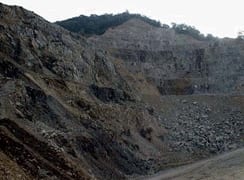Discovery

Cadmium was discovered in 1817 by a physician, Friedrich Stromeyer (1776-1835). The element was first found in the condensation of vapors (mixed with soot and zinc oxides) that rose out of a furnace in which zinc oxide was being roasted. Cadmium’s discovery is also loosely attributed to K.S.L. Hermann and J.C.H. Roloff who may have found cadmium in zinc oxide during the same year. A historical debate still remains as to who actually discovered the pure form of the element first.
The phase of scientific history in which Stromeyer was active was one in which chemical discovery was being accomplished primarily by pharmacists, apothecaries and physicians. The practice of alchemy was dying out, and chemistry was just beginning to emerge as a separate science. Stromeyer, a professor at the University of Göttingen, was testing zinc oxide, a medicine in those days, for purity.
The name of the element was derived from the Latin “cadmia” and the Greek “kadmeia,” both ancient names for calamine (zinc carbonate).
The phase of scientific history in which Stromeyer was active was one in which chemical discovery was being accomplished primarily by pharmacists, apothecaries and physicians. The practice of alchemy was dying out, and chemistry was just beginning to emerge as a separate science. Stromeyer, a professor at the University of Göttingen, was testing zinc oxide, a medicine in those days, for purity.
The name of the element was derived from the Latin “cadmia” and the Greek “kadmeia,” both ancient names for calamine (zinc carbonate).
A Brighter Shade of Yellow
One of the earliest known uses of cadmium after its discovery was in pigments. By the 1840s, cadmium compounds were being produced, yielding brilliant colors from pale yellow to deep orange. These pigments were used mainly in paints and consisted primarily of cadmium sulfide, which was prepared by heating cadmium salts in hydrogen sulfide gas until a powdery precipitate formed. Apparently the durability of the resulting pigment could be drastically improved in the preparation phases by ensuring that no excess solid sulfur was in the powder. Cadmium pigments tended to be used sparingly because cadmium is such a rare metal.
Leather workers also used cadmium as a tanning agent for leather goods in addition to many other metals now known to be toxic, such as nickel, lead, arsenic, and mercury.
Rust Buster
Other than pigments and tanning dyes, the use of cadmium in industry was fairly limited until the mid-1900s when metallurgists began to coat metals with cadmium to increase their corrosion resistance through a process known as electroplating. Cadmium ions in solution could be electrically attracted to the surface of a metal submerged in a cadmium salt solution, resulting in a thin layer of cadmium that could protect the underlying material from corrosion.
Cadmium also found its way into the materials revolution after World War II to chemically stabilize certain plastics.
Today, cadmium is most widely used in rechargeable, nickel-cadmium batteries (Ni-Cd or Ni-Cad). Because of their cadmium content, consumers are advised to properly recycle these batteries.
Setting a Standard
In 1927 cadmium was used by the International Conference on Weights and Measures to define the length of the meter. Every element has a unique set of spectral lines that are produced when electrons surrounding the nucleus of the atom jump from higher to lower energy levels. Each spectral line corresponds to a precise frequency of light. The conference used the red spectral line of cadmium as the standard for distance and defined the unit length of the meter as 1.553,164.13 wavelengths of this specific kind of red light. The definition was changed in 1960 to be measured by the orange-red spectral line of krypton. On October 20, 1983, the standard was redefined again. The new definition established that “the meter is the length of the path traveled by light in vacuum during a time interval of 1/299,792,458 of a second. “
In all of these changes the goal was improving the precision of the definition while changing its actual length as little as possible.
Early Warning Signs and the “Itai-Itai” Disease
Cadmium’s toxicity was not widely known until the Industrial Revolution accelerated the mining and production of the metal and human exposure to cadmium increased. Though the metal was never used as a poison it did find use in medicine. Despite its toxicity, the 1907 British Pharmaceutical Codex listed the compound cadmium iodide as a medicine to combat “enlarged joints, scrofulous glands, and chilblains.”
Ironically, the toxicity of this “medicine” was partially responsible for its discovery. The reason that Stromeyer was asked to investigate samples of zinc oxide was to test it for purity. Zinc oxide was prescribed by 18th-century Germany physicians. Rumors began to spread that patients had been poisoned by taking zinc oxide, and several physicians were asked to test samples of zinc oxide from various pharmacies. Some suggested that arsenic contamination was the culprit; others disagreed. Stromeyer resolved the dispute and concluded that he had indeed discovered the new metal, cadmium.
The first recorded incident of occupational cadmium exposure occurred in Belgium in 1858. Workers polishing silver with cadmium carbonate inhaled cadmium dust. This kind of exposure can produce severe health consequences ranging from nausea and respiratory problems to death

But true scrutiny over the toxic effects of cadmium exposure did not come until 1945 when the fall-out from chronic cadmium poisoning incidents in Japan caused an uproar over the metal. In the prefecture of Toyama, the Kakioma mining facility was digging for zinc ore. Cadmium is also typically found in zinc ores, and therefore the run-off water flowing out of the mine was laden with dissolved cadmium.
Local farmers in the region used this run-off water to irrigate crops. Crops such as rice are known to heavily retain cadmium absorbed from the environment. Cadmium, once localized to the zinc ore beneath the Toyama province, spread through run-off water into local rice patties and eventually the local diet.
Residents soon began to notice the disturbing symptoms of what later came to be known as “Itai-Itai” Disease. They experienced pain in their bones and joints, which eventually became so excruciating that they were bed-ridden. The cadmium, it was later found, had reduced the calcium content and density of their bones In some cases, simple movements caused the weakened bones to break. Cadmium poisoning through ingestion is known for the extreme pain that it causes, which is why the affliction became known as “Itai-Itai” or “Ouch-Ouch” Disease.
Studies and regulatory actions involving cadmium exploded after this incident, and research performed in the United States in the 1960s confirmed the carcinogenic effects of the metal through rodent and epidemiological studies. Today cadmium levels both in the workplace and in the environment are regulated by the federal government through the Occupational Safety Hazard Association (OSHA) and the U.S. Environmental Protection Agency (EPA).
The Open-Air Testing Debate
Cadmium has been the center of an ongoing debate about the health effects of secret Army tests conducted during the 1950s and 1960s. Because of fears during the Second World War that a foreign country might develop biological weapons and use them against the United States, President Franklin D. Roosevelt established the U.S. Biological Warfare Program as a research initiative to counter the threat. At the height of research in the 1950s and 1960s, the program conducted large-scale, secret tests over 33 major U.S. cities including Minneapolis, Corpus Christi, TX, Fort Wayne, IN, and St. Louis, MO.
To simulate a large-scale biological attack, particles of zinc cadmium sulfide (ZnCdS) were dispersed into the air from trucks at target locations outside of these cities. The ZnCdS was intended to simulate bacteria particles, allowing army researchers to study how biological warfare agents disperse in the atmosphere and to determine how much of such an agent would be required to target an urban population. ZnCdS was chosen because it was fluorescent under ultra-violet lamps, it was inexpensive, and it was thought to be harmless to plants and animals at the time. Over 300 tests were conducted around the nation at different times of day so that essentially all sectors of the population in each city were exposed to the chemical.
When news of the tests was finally made public in the 1990s, a public outcry in the affected cities quickly ensued, and many people came forward attributing everything from reproductive disorders to cancer to the ZnCdS spraying tests. Army researchers claimed that their data indicated the chemical was harmless; however Congress commissioned a study to investigate the series of incidents and see whether ZnCdS actually poses any significant health risk.
The National Research Council’s Committee on Toxicology published a report on the dispersion testing in 1997. They concluded that, while cadmium and various cadmium compounds including cadmium sulfide are both poisonous and carcinogenic to humans and animals, it was not evident that these compounds were bioavailable — in a form that would be toxic to the body — to test subjects during the army’s tests. In effect, the panel dismissed that the spraying of ZnCdS could have had any ill effects.
Cadmium at Ground Zero

In the aftermath of the terrorist attacks of September 11th, 2001, rescue and aid workers at New York’s World Trade Center site were exposed to a billowing cloud of smoke that emanated from the rubble of the fallen buildings. Many workers developed respiratory problems that quickly came to be known as “WTC cough,” and officials began to wonder whether the fumes contained dangerous, carcinogenic metals such as cadmium.
A National Medical Services study of roughly 10,000 aid workers from the WTC site indicates safe levels of heavy metals and other toxins. Some workers did in fact show elevated levels of cadmium, but this was attributed to dust from saw blades and not from exposure to smoke.
The United States Environmental Protection Agency (EPA) has released statements regarding the chemical contents of the smoke at the World Trade Center site. These studies indicate that many heavy metals such as cadmium and manganese were below screening levels altogether.


